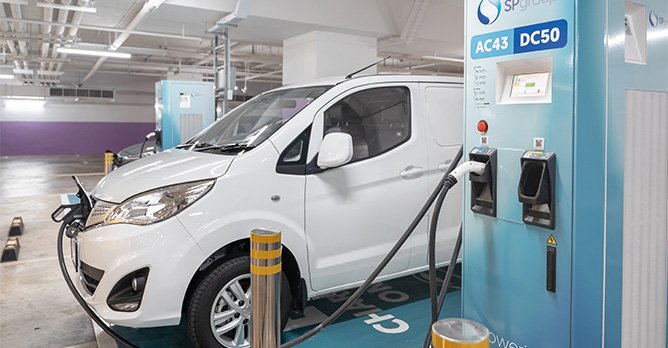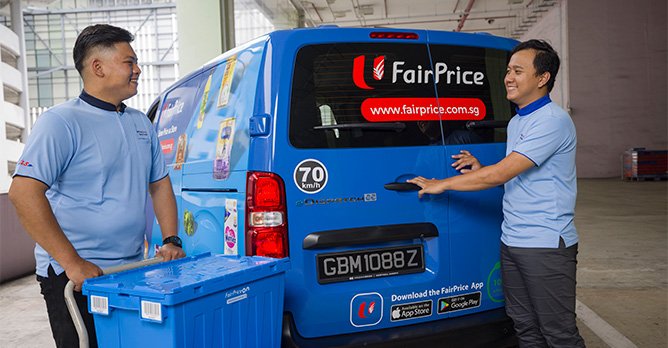LTA: Rebates for cleaner-energy commercial vehicles to continue till 2025, albeit in smaller amounts
15 Nov 2022|1,844 views
Previously thought to have been under threat, schemes encouraging businesses to register and utilise cleaner-energy commercial vehicles (CVs) have been granted a longer lease of life.
The LTA announced on 15 November 2022 that it would be extending both the Commercial Vehicle Emissions Scheme (CVES) and Early Turnover Scheme (ETS) for two years, up till 31 March 2025. Uncertainty had recently swirled around the future of these schemes, as they had initially been due to last only up till 2023.

 The government is still working towards its end goal of all vehicles running on cleaner energy by 2040 Under the two schemes, rebates are handed out for the registration of cleaner energy vehicles.
The government is still working towards its end goal of all vehicles running on cleaner energy by 2040 Under the two schemes, rebates are handed out for the registration of cleaner energy vehicles.
Operating with fixed incentive amounts, the CVES is broader, targeting the registration of any new light commercial vehicle (LCV).
On the other hand, the ETS aims to encourage businesses currently operating diesel and diesel-electric CVs to replace their vehicles with petrol-engined or all-electric ones before their COE terms have ended. Discounted prevailing quota premiums (PQPs) are handed out under the ETS.
Nonetheless, the picture is not entirely rosy, as incentives for LCVs under the CVES are set to fall across both bands.
Band A, which applies to electric LCVs, will fall from $30,000 to $15,000 - in order to reflect what the LTA believes are their "narrowing upfront cost premium and lifecycle costs". Band B, which largely comprises petrol-engined models, will also see incentives fall from $10,000 to $5,000.
Contrarily, surcharges for more pollutive internal combustion engine (ICE) models in Band C are set to rise. Mostly implicating diesel-powered LCVs, the surcharge will rise from $10,000 to $15,000.
Likewise, COE bonuses will fall under the ETS come 2023, which also applies to heavy commercial vehicles (HCVs). The ETS will be discontinued after 2025.
Finally, 2023 will also see the more rigorous Worldwide Harmonised Light Vehicles Test Procedure (WLTP) used solely for the testing of LCVs. Pollutant thresholds will be adjusted accordingly.
All things considered, continuing an overarching policy that encourages the adoption of cleaner-energy CVs while reducing rebate amounts may just be the right thing to do, given the staggering rise in commercial vehicle prices this year.
According to The Straits Times, COE premiums in Category C have risen more than 80% between January and November, standing at $76,302 most recently. Additionally, there are now more fully electric CVs - 1,430 of them to be exact - on our roads than ever before. This represents a more than 300% increase within less than a year.
The LTA announced on 15 November 2022 that it would be extending both the Commercial Vehicle Emissions Scheme (CVES) and Early Turnover Scheme (ETS) for two years, up till 31 March 2025. Uncertainty had recently swirled around the future of these schemes, as they had initially been due to last only up till 2023.

Operating with fixed incentive amounts, the CVES is broader, targeting the registration of any new light commercial vehicle (LCV).
On the other hand, the ETS aims to encourage businesses currently operating diesel and diesel-electric CVs to replace their vehicles with petrol-engined or all-electric ones before their COE terms have ended. Discounted prevailing quota premiums (PQPs) are handed out under the ETS.
Nonetheless, the picture is not entirely rosy, as incentives for LCVs under the CVES are set to fall across both bands.
Band A, which applies to electric LCVs, will fall from $30,000 to $15,000 - in order to reflect what the LTA believes are their "narrowing upfront cost premium and lifecycle costs". Band B, which largely comprises petrol-engined models, will also see incentives fall from $10,000 to $5,000.
Contrarily, surcharges for more pollutive internal combustion engine (ICE) models in Band C are set to rise. Mostly implicating diesel-powered LCVs, the surcharge will rise from $10,000 to $15,000.
Likewise, COE bonuses will fall under the ETS come 2023, which also applies to heavy commercial vehicles (HCVs). The ETS will be discontinued after 2025.
Finally, 2023 will also see the more rigorous Worldwide Harmonised Light Vehicles Test Procedure (WLTP) used solely for the testing of LCVs. Pollutant thresholds will be adjusted accordingly.
All things considered, continuing an overarching policy that encourages the adoption of cleaner-energy CVs while reducing rebate amounts may just be the right thing to do, given the staggering rise in commercial vehicle prices this year.
According to The Straits Times, COE premiums in Category C have risen more than 80% between January and November, standing at $76,302 most recently. Additionally, there are now more fully electric CVs - 1,430 of them to be exact - on our roads than ever before. This represents a more than 300% increase within less than a year.
Previously thought to have been under threat, schemes encouraging businesses to register and utilise cleaner-energy commercial vehicles (CVs) have been granted a longer lease of life.
The LTA announced on 15 November 2022 that it would be extending both the Commercial Vehicle Emissions Scheme (CVES) and Early Turnover Scheme (ETS) for two years, up till 31 March 2025. Uncertainty had recently swirled around the future of these schemes, as they had initially been due to last only up till 2023.

 The government is still working towards its end goal of all vehicles running on cleaner energy by 2040 Under the two schemes, rebates are handed out for the registration of cleaner energy vehicles.
The government is still working towards its end goal of all vehicles running on cleaner energy by 2040 Under the two schemes, rebates are handed out for the registration of cleaner energy vehicles.
Operating with fixed incentive amounts, the CVES is broader, targeting the registration of any new light commercial vehicle (LCV).
On the other hand, the ETS aims to encourage businesses currently operating diesel and diesel-electric CVs to replace their vehicles with petrol-engined or all-electric ones before their COE terms have ended. Discounted prevailing quota premiums (PQPs) are handed out under the ETS.
Nonetheless, the picture is not entirely rosy, as incentives for LCVs under the CVES are set to fall across both bands.
Band A, which applies to electric LCVs, will fall from $30,000 to $15,000 - in order to reflect what the LTA believes are their "narrowing upfront cost premium and lifecycle costs". Band B, which largely comprises petrol-engined models, will also see incentives fall from $10,000 to $5,000.
Contrarily, surcharges for more pollutive internal combustion engine (ICE) models in Band C are set to rise. Mostly implicating diesel-powered LCVs, the surcharge will rise from $10,000 to $15,000.
Likewise, COE bonuses will fall under the ETS come 2023, which also applies to heavy commercial vehicles (HCVs). The ETS will be discontinued after 2025.
Finally, 2023 will also see the more rigorous Worldwide Harmonised Light Vehicles Test Procedure (WLTP) used solely for the testing of LCVs. Pollutant thresholds will be adjusted accordingly.
All things considered, continuing an overarching policy that encourages the adoption of cleaner-energy CVs while reducing rebate amounts may just be the right thing to do, given the staggering rise in commercial vehicle prices this year.
According to The Straits Times, COE premiums in Category C have risen more than 80% between January and November, standing at $76,302 most recently. Additionally, there are now more fully electric CVs - 1,430 of them to be exact - on our roads than ever before. This represents a more than 300% increase within less than a year.
The LTA announced on 15 November 2022 that it would be extending both the Commercial Vehicle Emissions Scheme (CVES) and Early Turnover Scheme (ETS) for two years, up till 31 March 2025. Uncertainty had recently swirled around the future of these schemes, as they had initially been due to last only up till 2023.

Operating with fixed incentive amounts, the CVES is broader, targeting the registration of any new light commercial vehicle (LCV).
On the other hand, the ETS aims to encourage businesses currently operating diesel and diesel-electric CVs to replace their vehicles with petrol-engined or all-electric ones before their COE terms have ended. Discounted prevailing quota premiums (PQPs) are handed out under the ETS.
Nonetheless, the picture is not entirely rosy, as incentives for LCVs under the CVES are set to fall across both bands.
Band A, which applies to electric LCVs, will fall from $30,000 to $15,000 - in order to reflect what the LTA believes are their "narrowing upfront cost premium and lifecycle costs". Band B, which largely comprises petrol-engined models, will also see incentives fall from $10,000 to $5,000.
Contrarily, surcharges for more pollutive internal combustion engine (ICE) models in Band C are set to rise. Mostly implicating diesel-powered LCVs, the surcharge will rise from $10,000 to $15,000.
Likewise, COE bonuses will fall under the ETS come 2023, which also applies to heavy commercial vehicles (HCVs). The ETS will be discontinued after 2025.
Finally, 2023 will also see the more rigorous Worldwide Harmonised Light Vehicles Test Procedure (WLTP) used solely for the testing of LCVs. Pollutant thresholds will be adjusted accordingly.
All things considered, continuing an overarching policy that encourages the adoption of cleaner-energy CVs while reducing rebate amounts may just be the right thing to do, given the staggering rise in commercial vehicle prices this year.
According to The Straits Times, COE premiums in Category C have risen more than 80% between January and November, standing at $76,302 most recently. Additionally, there are now more fully electric CVs - 1,430 of them to be exact - on our roads than ever before. This represents a more than 300% increase within less than a year.
Latest COE Prices
November 2025 | 1st BIDDING
NEXT TENDER: 19 Nov 2025
CAT A$110,002
CAT B$115,001
CAT C$76,000
CAT E$121,010
View Full Results Thank You For Your Subscription.






















